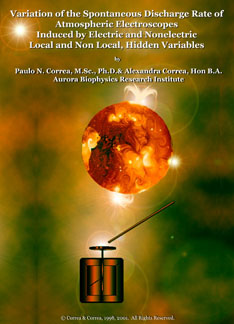![Akronos logo]](/images/akronos_wheel.jpg)
|
Akronos Publishing Concord, ON, Canada www.aetherometry.com |
![Akronos logo]](/images/akronos_wheel.jpg)
|
Akronos Publishing Concord, ON, Canada www.aetherometry.com |

Variation of the spontaneous discharge rate of atmospheric electroscopes
induced by electric and nonelectric, local and nonlocal, hidden variables
by Correa, Paulo N. & Correa, Alexandra N.
Published in July 2001. 90 pages.
Experimental Aetherometry, Vol. 1
Monograph AS2-02
Price: US $20 ($16 ISFA)
This monograph is also included in the print edition of Experimental Aetherometry, Vol. 1
|
ABSTRACT
In a previous paper we have suggested a novel methodological approach, both theoretical and experimental, to determine the nonelectric power capacity of a local medium to regenerate the kinetic energy of charge trapped in a conductor, which kinetic energy this trapped charge spends in performing work against gravity - as in the deflection of an electroscopic leaf. In the present study, we are interested in understanding the roles electric and nonelectric factors play in affecting and controlling the spontaneous discharge rates of electroscopes that are both positively and negatively charged. For this purpose we studied the variation of the spontaneous discharge rates of identical, calibrated, gold-leaf electroscopes directly exposed for a monthly period to varying outdoors atmospheric conditions, and how the observed rate variation correlated, or not, with local atmospheric parameters or nonlocal parameters of solar origin. Comparative studies with the effect of a negative ion generator were also carried out. We found that atmospheric electroscopes essentially respond to a total of five distinct hidden variables, which fall into two groups - those that accelerate the spontaneous discharge rate and those that slow it down or arrest the discharge. In the first group, we have two local and two nonlocal factors at play. The local factors are essentially nonelectric. The first local factor refers to the capacity or ability of cloud systems, particularly those associated with low pressure cells, to draw nonelectric energy from neighbouring localities and thus diminish the kinetoregenerative power of the medium local to the instruments. This effect can be observed typically during daytime and often during the midday period, even with high-pressure cells, and it is essentially a short range effect. The other local, nonelectric factor at play, which correlates with rate acceleration, is the cyclic night time increase in humidity. The two local factors are in all likelihood related, as the capacity of cloud systems to draw energy from their surroundings is likely connected to the capacity of the water molecule to absorb the same nonelectric medium energy. The two nonlocal factors that we have identified as being able to accelerate electroscopic discharge rates are solar sourced parameters, one electric and the other nonelectric. The former refers to the solar emission of 'relativistic' electrons (>0.6MeV) involved in brehmstrahlung and synchrotron radiation, and the latter refers to solar X-ray emission, particularly to those events which are X-ray flares often associated with optical flares in the H-alpha line. Quite often the two emissions are associated, particularly on the occasion of X-ray flares. Essentially, the electric effect of solar electron emissions is of short duration, unbalancing the rates of discharge of oppositely charged atmospheric electroscopes, whereas the effect of X-radiation seems to be a long-range effect that displaces upwardly the baseline of the spontaneous discharge rate of all atmospheric electroscopes. But while all these hidden variables can only accelerate the electroscopic spontaneous discharge rate, the fifth hidden variable, which alone stands in the second group, proved to be of solar origin and to have precisely the opposite effect, in that it arrests the discharge, or tends towards its arrest. Only this nonlocal variable therefore could account for the power of the local medium to regenerate the kinetic energy which charge spends in performing work against gravity when trapped in a conductor subject, in turn, to electrostatic repulsion. Essentially, the kinetoregenerative power of the local medium is in turn replenished by this component of solar radiation. However, we could not, in the context of the present investigation, determine the nature of this nonelectric and nonionizing derivative of solar energy driving the power of the local medium to regenerate the kinetic energy of trapped charge. In atmospheric electroscopes, it correlates with the temperature variation of the solar heating of the earth's atmosphere - raising the possibility that this nonlocal variable might consist of the continuum blackbody thermal radiation emitted by the sun, or part of it (radio, IR, visible or nonionizing UV). To integrate our findings, we propose a novel foundation for a comprehensive theory of the electric and nonelectric energy functions of the electroscope, and further perform some critical tests of the effect of electric fields upon the electroscope, employing a negative ion generator for this purpose. |